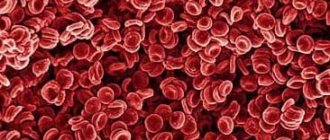Infectious disease specialist
Sinitsyn
Olga Valentinovna
33 years of experience
Highest qualification category of infectious disease doctor
Make an appointment
HIV (human immunodeficiency virus) is a virus that attacks the body's immune system. More precisely, it targets certain immune cells and kills them. The longer and more active this process lasts, the weaker the immune system becomes - over time, it is simply unable to cope even with infections that are relatively safe for an ordinary person.
If my partner tests negative for HIV, is he not infected?
Unfortunately, obtaining a false negative result is also possible. If your partner tests negative for HIV and you test positive twice, he or she needs to be tested again. According to information taken from AIDS.gov (an information portal on HIV/AIDS), the likelihood of obtaining a false negative test result depends on the length of time between possible exposure to HIV infection and the time of testing: “Seroconversion takes a certain time to occur. Seroconversion is the production of specific antibodies in response to the appearance of HIV. This process takes from two weeks to six months after infection. The work of the diagnostic test system is aimed at detecting antibodies. Therefore, if you test negative for HIV within three months of your last possible exposure, the CDC recommends testing again three months after your first screening test. A negative result indicates the absence of infection as a result of contacts that occurred more than six months ago. The accuracy of a negative result is certain if you have not been exposed to HIV infection in the past six months.”
Mechanism and factors of transmission of HIV infection
30.Nov.2020
HIV infection
– a disease caused by the human immunodeficiency virus – an anthroponotic infectious chronic disease characterized by a specific lesion of the immune system, leading to its slow destruction until the formation of acquired immunodeficiency syndrome (AIDS), 8 accompanied by the development of opportunistic infections and secondary malignant neoplasms.
AIDS
– a condition that develops against the background of HIV infection and is characterized by the appearance of one or more diseases classified as AIDS-indicative. AIDS is an epidemiological concept and is used for the purposes of epidemiological surveillance of HIV infection.
Mechanism and factors of transmission of HIV infection
There are 2 transmission mechanisms: The natural mechanism of HIV transmission includes: • contact, which occurs primarily during sexual contact (both homo- and heterosexual) and through contact of the mucous or wound surface with blood; • vertical (infection of a child from an HIV-infected mother: during pregnancy, childbirth and breastfeeding).
Artificial transmission mechanisms include:
• artificial during non-medical invasive procedures, including intravenous drug administration (use of syringes, needles, other injection equipment and materials), tattooing, when performing cosmetic, manicure and pedicure procedures with non-sterile instruments;
• artificial for invasive interventions in medical organizations. HIV infection can occur through the transfusion of blood, its components and drugs, organ and tissue transplantation, the use of donor sperm, donated breast milk from an HIV-infected donor, as well as through medical instruments for parenteral interventions, medical products contaminated with HIV and not processed in accordance with the requirements of regulatory documents.
Main factors
transmission of the pathogen are human biological fluids (blood, blood components, sperm, vaginal discharge, breast milk).
HIV infection is not transmitted! TO
through contact and household contact: through kissing, shaking hands, playing sports together, using shared dishes, cutlery, towels, as well as insect bites. In saliva, tear fluid and urine, the concentration of the virus is low, so infection through these biological fluids is also impossible.
How to determine whether a person is infected with HIV or not?
At the beginning of the disease, a person does not feel any signs of illness. Therefore, if you have ever used drugs, had unprotected sex, if you care about your health and the health of your loved ones, then you need to get tested for HIV. A small amount of blood is taken from a vein for analysis. The test will help determine the presence of antibodies to the virus. Antibodies are blood plasma proteins that the body produces in response to the penetration of a foreign substance - a virus. The HIV antibody test can be taken at the AIDS Prevention and Control Center and other medical institutions. Testing for HIV won't take you long. It is carried out free of charge and confidentially - only you and the attending physician will know about the result.
Seronegative window.
There is no point in doing an HIV test immediately after situations during which infection could have occurred; time must pass from the moment of HIV infection until the appearance of antibodies in the blood, the presence of which makes a diagnosis of HIV infection (usually three months). During this period, it is especially necessary to take measures to avoid possible infection (if you have not yet become infected), as well as to eliminate the risk of transmitting the virus to other people if the virus has already entered your body.
Why do you need to know about your HIV status?
• If the result shows that you do not have HIV, but you know that your behavior is associated with a risk of infection, you can change it and avoid infection in the future. • If the result shows that you have HIV, you should immediately seek medical help to prevent the occurrence of diseases that threaten your life. The sooner the examination is carried out and treatment begins, the greater your chances of maintaining health. • If you know that you have HIV, you can protect those around you from infection - both sexual partners and people in your circle, including drug users. • If you have HIV and are planning motherhood, you can significantly reduce (to 2% or less) the risk of transmitting the virus to your child if you promptly seek help from doctors and regularly take special medications that will be prescribed at the AIDS center. • If you know that you have HIV, and your partner does not have HIV, you can agree on safe sexual behavior that will not lead to the transmission of HIV to your partner, and, moreover, will allow you to have healthy children. • Knowing the result of the examination, you will get rid of anxious thoughts that you may have HIV, but you don’t know about it.
• Modern treatment for HIV infection is available in Russia and is provided free of charge.
Treatment of HIV infection.
In the absence of treatment, the majority of HIV-positive people's health sooner or later begins to deteriorate; every year the virus increasingly weakens the human immune system, which leads to the development of various diseases, which are also called secondary diseases - fungal infections (candidiasis), Kaposi's sarcoma, some types of cancer, Pneumocystis pneumonia, severe forms of tuberculosis, as well as other diseases. The drugs that are used to treat HIV infection are called antiretrovirals (ARVs), and the treatment of HIV infection with these drugs is called antiretroviral therapy (ART). Three or more ARV drugs are used to treat HIV infection. This treatment is called highly active antiretroviral therapy (ART). ART does not destroy the virus, but is very effective in preventing it from entering human cells and multiplying inside cells, affecting the main stages of the HIV life cycle. This reduces the number of viruses in the body or, in other words, reduces the viral load. The more healthy immune cells in the body, the less HIV there is, the more effectively the immune system protects the body from other diseases, and the better a person feels. The need to influence several stages of viral replication explains the need to take at least three ARV drugs; with their help, you can completely stop the replication of HIV, but you will have to take them constantly throughout your life.
Regina Sibagatullina,
infectious disease doctor, Nyagan City Children's Clinic
How could I get HIV?
You will have to ask and answer this question repeatedly. You most likely became infected through contact with the blood or semen of an HIV-positive person. The most common ways of transmitting HIV include unprotected anal or vaginal sex, and sharing syringes and needles (whether the substance administered is a narcotic or a medication such as gender reassignment hormones). According to the Centers for Disease Control and Prevention, HIV infection can occur through exposure to blood and blood products, blood transfusions, or organ transplants, although “strict screening procedures for blood and organ donation in the United States keep this risk to an absolute minimum.”
Is it true that many HIV-positive people have hepatitis C?
Yes. In the United States, 25 to 30 percent of people living with HIV have hepatitis C (or HCV). This is a major concern because HIV accelerates the spread of HCV in the body, leading to earlier development of cirrhosis and end-stage liver disease. According to the Los Angeles Bureau of AIDS Prevention and Control, ways of transmitting HCV include sharing needles or personal items with blood residue (shaving or manicure utensils, toothbrushes, blood glucose meters), unsterile tattoo and piercing equipment, or sexual contact without using a condom with a person infected with HCV. The risk of contracting hepatitis C increases with rough sex, having a large number of sexual partners, and if you have HIV or sexually transmitted diseases. There is good news: although a vaccine against HCV has not yet been developed, there are modern effective treatments for hepatitis C. If one type of treatment fails, alternative treatment options are available that may help. Be sure to consult your doctor.
The immune system
In order to understand how the human immunodeficiency virus (that’s what HIV stands for) destroys the immune system, you first need to understand what it is - the immune system. According to one of the definitions (according to R.V. Petrov), immunity is a way of protecting the body from living bodies and substances that carry signs of genetic foreignness. Simply put, immunity is what protects us from bacteria, viruses, any high-molecular foreign substances (remember immunity against snake venom) that enter the body, as well as cancer cells. It is based on phagocytes (called macrophages in animals), which actually destroy (absorb) foreign bodies, as well as T- and B-cells of the immune system, which carry out the precise “guiding” of phagocytes towards the pathogen. When a microbe enters the body, phagocytes absorb and digest it [29].
Primary enemy recognition occurs through Toll-like receptors, or TLRs [30]. These molecules recognize structures common to many classes of pathogens, but absent in humans (for example, TLR5 recognizes the protein flagellin, the main component of bacterial flagella, and TLR3 is activated by the presence of double-stranded RNA, which appears in the life cycle of many viruses, in particular the influenza A virus ). After the microbe is absorbed, its remains are “showed” (presented) to T-helper cells. T-helper cells are activated, and in turn help B-lymphocytes to activate (the latter require pathogen molecules and activation signals from T-helper cells for activation). After this, the B lymphocytes turn into plasma cells and begin the synthesis of antibodies - immunity molecules that mark substances similar to those that activated the B lymphocytes. Antibodies circulate in the bloodstream and mark the structures of the pathogen. Marked microbes and other foreign bodies are absorbed by phagocytes more efficiently.
This “scenario” works when the microbe is outside the body’s cells (in the case of infection with most bacteria and fungi). If the enemy penetrates inside the cell (viruses, some bacteria, protozoa), as well as when the body cell itself becomes hostile (in the case of cancer), T-killers come into play. They find and destroy infected cells, after which the remains of these cells are absorbed by the same phagocytes. Killer T cells require helper T cells to activate. In addition to T-killers, antibodies (and, accordingly, B-lymphocytes) are involved in this “scenario”, but their role is less than that of T-killers. Of course, there are other participants in immunity, but the main emphasis in the fight against HIV falls on those mentioned above.
Figure 1. Simplified diagram of the immune response. Lightning bolts indicate how one cell type activates others. Mf - macrophage, B - bacterium, TX - T-helper, BCl - B-cell, PlCl - plasma cell, At - antibodies, B+At - bacterium covered with antibodies that attract macrophages, B - virus, ZMf - infected macrophage, TK - T-killer, ZK - cell infected with a virus, UK - dying (apoptotic) cell, B+Ab - virus coated with antibodies.
drawing by the author of the article
If I am HIV positive, does that mean I have AIDS?
No, that's not true. People and even members of the media very often confuse HIV with AIDS or use these concepts interchangeably. AIDS, or late-stage HIV infection, will never develop in most HIV-positive people living in the United States. HIV is the virus that causes AIDS, but in most cases, proper treatment and regular medical supervision can prevent a weakened immune system and the development of AIDS. A positive HIV test result means only one thing: you are infected with HIV. AIDS is an independent disease, and many doctors prefer not to use this term, replacing it with the more understandable “third stage of HIV infection.”
When did AIDS appear in the world?
Only in 1983, this terrible disease was officially registered in 40 countries. It became clear that a previously unknown infection was rapidly spreading among the population of different countries, adding more and more new victims to its list.
AIDS has changed the attitude towards many phenomena in biology, expanding the boundaries of medical knowledge and at the same time showing humanity how powerless it is in solving certain processes in the body.
Already in 1988, AIDS swept through 138 countries, infecting several thousand people. For the first time, scientists around the world were unanimous and concerned about the danger that the virus posed to the world's population. Moreover, it was not the sick, but the infected people who caused particular concern, because they did not even know about their infection and posed a danger to the healthy population. The most vulnerable victim among the population was the youth, the future and hope of all humanity. The first case of infection in Russia was recorded in 1987.
I will die?
Yes, but not tomorrow and not because you have HIV. The fact is that with proper treatment, HIV-positive patients can live as long and fulfilling lives as healthy people. You are much more likely to die in a car accident than to die from HIV. Of course, as with any chronic disease (such as diabetes), you may develop certain complications. In addition, you may be susceptible to various diseases, like everyone else. There is evidence that long-term use of antiretroviral drugs, which must be taken by HIV-positive people, increases the risk of early development of certain age-related diseases, such as osteoporosis. However, do not forget that adherence to treatment will allow you to live a long and active life despite HIV.
The first signs of the disease: symptoms in the early stages
The treacherous nature of the infection lies in the fact that HIV in its early stages either proceeds latently (that is, with virtually no initial symptoms) or is mistaken for another disease with similar symptoms. According to some statistics, in the female population, signs of HIV appear more clearly, and therefore diagnosing the disease is noticeably easier. Such consolation may be weak, but it certainly inspires clear hope for a more favorable outcome. What are the initial signs of HIV in women infected with this disease?
This is the problem: neither on the 1st day after contracting HIV infection, nor on the 5th, and in general, during the first 2 weeks, a woman may not even realize that a terrible infection is developing inside her .
But in the period between the 2nd and 6th weeks from the start of the virus entering the body, the first symptoms of HIV may manifest themselves as the following:
- an infected woman suddenly develops a high (up to 38-40 °C) body temperature;
- the condition is aggravated by signs of chills, fever, general loss of strength, muscle pain;
- the following changes occur in the digestive system: diarrhea that occurs without prior dietary disturbances, nausea, and sometimes vomiting;
- a woman's night sleep is accompanied by increased sweating;
- menstruation, if it occurs during this period, occurs more abundantly, and increased intrapelvic pain joins the pathology (what to do with painful periods is described here);
- lymph nodes located in the neck, armpits or groin area (and possibly simultaneously in all these places) increase significantly in size; at an early stage, the symptom may not be visualized, but is easily detected by palpation;
- this condition can last from 2-3 days or more, but not longer than 7-10 days;
- recurrent fungal infections of any location; shingles.
Due to the similarity and non-uniqueness of the symptoms of HIV, in the early stages they are mistaken for colds, flu, mononucleosis, and so on, which they prefer to treat independently at home. But consultation with a doctor should not be neglected in any case, because only if HIV infection is detected at an early stage and undergoes adequate treatment, the disease does not become a death sentence.
When should treatment begin?
Right now. Treatment should be started as soon as possible, preferably on the day of a positive HIV test result. Early initiation of HIV treatment results in significant long-term benefits. But even if there are no symptoms, the infection weakens the immune system. According to scientists, delaying the initiation of antiretroviral therapy leads to an increase in the volume of hidden reservoirs of HIV infection. In contrast, early treatment reduces viral load. The level of virus in the blood may drop to below detectable levels, at which the likelihood of transmitting HIV to a partner is extremely low. So get a prescription immediately and start taking the medications.
How is HIV different from AIDS?
Sometimes people do not understand the difference between HIV and AIDS and equate them. However, there is a big difference between these problems regarding the future life prospects of men.
If you start treating the first one in time, then you will be able to avoid the second one. HIV infection at an early stage leads to a decrease in the efficiency of the immune system. It can be determined through analyzes and tests after suspicion at the first signs of the disease. AIDS is a syndrome in which the body has a weak immune system.
The immunodeficiency virus enters lymphocytes, where it multiplies. This is an early stage of the disease. The cells of the immune system quickly die, and the men’s body does not have time to restore them in the required quantity - these are the first, but serious signs of a problem. If left untreated, over time there will be less than 200 lymphocytes in one milliliter of blood - and this is AIDS. Modern medicine does not allow us to completely get rid of the pathogen. However, the activity of the latter can be suppressed and a long life can be enjoyed.
Some patients undergo antiviral therapy for 30 years and remain relatively healthy.
This significant difference between HIV and AIDS gives many men a chance.
Should I take antiretroviral drugs every day?
All life? Yes and no. According to a study conducted in 2015, only when early treatment is combined with regular medication intake does the ratio of CD4 to CD8 cells become close to normal. The closer this indicator is to normal, the more cells fight HIV and give you strength, health and life expectancy as a person without HIV infection. These tangible health benefits should not be overlooked. However, both doctors and pharmaceutical companies understand that the need to take medications every day becomes a real challenge, and therefore they are developing new treatment options. A study this year found that injecting the drug twice a month is as effective as taking a pill every day (although it may take one to two years before such drugs are sold in pharmacies). Yes, you'll have to stick to your treatment religiously for now (think of it as going to the gym or taking your daily vitamins), but that doesn't mean you're doomed to take pills every day for the rest of your life.
How can I protect my sexual partners?
There are different ways to protect yourself and your partner. Discuss your HIV status and its risk of transmission honestly and thoroughly. Always use a condom and have sex with a partner using pre-exposure prophylaxis (PrEP). Monitor viral load to remain below detectable levels. Even the correct choice of condom lubricant is important (avoid two components: polyquaternium and polyquaternium-15, as both types of polymer increase the risk of HIV transmission).
What does “treatment as prevention” mean?
Treatment with antiretroviral drugs reduces the concentration of the virus in the blood. The goal of therapy is to reduce the “viral load” to such a low level that “the virus cannot be detected in the blood.” Large studies have been conducted involving homosexual and heterosexual discordant couples in which only one partner was HIV-positive. The results show that when an HIV-positive partner's viral load drops below detectable levels, the risk of transmitting the virus does not exceed 5 percent (even without using condoms). As your health improves, your chance of passing HIV to someone else decreases. If everyone living with HIV got the treatment they need, we could prevent most new infections.
Ways to destroy the immune system
Let's now move on to how the virus destroys the immune system. Basically, it all comes down to the activation of programmed cell death, or apoptosis, in T cells (Normally, apoptosis is activated in cells that are defective or not needed by the body - for example, in the cells of the tail of a human embryo. Most potential cancer cells die by apoptosis. Moreover, if a cell “senses” infection by a virus using TLRs, it will try to die again through apoptosis (although almost all viruses have mechanisms to block it)). The production of the virus itself does not pass unnoticed for the T-helper, and over time it dies. The reasons for this are not fully understood, but several possible reasons can be identified.
When budding, the virus uses the cell membrane of the cell, and over time this should cause its destruction. In addition, the viral protein Vpu causes an increase in the permeability of the cell membrane [6]. When the virus is activated, double-stranded DNA that is not integrated into the genome appears in the cell [19], the presence of which can be considered by the cell as damage to its genetic material and induce its death through apoptosis (From the body’s point of view, such a cell can potentially become cancerous). In addition, viral proteins directly disrupt the balance of pro- and anti-apoptotic proteins in the cell. For example, the viral protease p10 can cut the antiapoptotic factor Bcl-2. The proteins Nef [26], Env [22] and Tat [24] are involved in an increase in the amount of cellular proteins CD95 and FasL, which serve as inducers of apoptosis, so-called. Fas-mediated pathway. The Tat protein positively regulates caspase 8 [2], a key factor in the induction of apoptosis.
If the cells do not die themselves, they are actively destroyed by T-killers. (This is a standard immune response to infection with any virus.)
In addition, during the production of gp120 and Tat, some of them are released into the bloodstream by the infected cell, and this has a toxic effect on the body [4], [28]. gp120 settles on all CD4+ cells (including healthy ones), which has three consequences:
- The CD4 protein is important for the interaction of the T-helper with the phagocyte, but when CD4 adheres to gp120, the T-helper ceases to perform this function.
- Antibodies are formed against gp120 as a foreign protein; After gp120 settles on healthy cells, the latter are marked with antibodies, and the immune system destroys them [9].
- After abundant binding of gp120 by the T helper cell, the cell itself dies. The fact is that CD4 is a coreceptor. It enhances the signal from TCR (T-cell receptor), the main protein that allows T cells to perform the immune function. Normally, these receptors are activated together. If one type of receptor is activated but not another, this is a signal that something has gone wrong and the cell dies through apoptosis.
Antibodies designed to prevent infection, in the case of HIV, often, on the contrary, enhance it [28]. Why this happens is not entirely clear. We discussed one reason above. Perhaps the fact is that antibodies cross-link several viral particles together, and not just one, but many viruses enter the cell at once. In addition, antibodies activate immune cells, and in an activated cell, viral proteins are synthesized faster.
In addition, gp120 and gp41 have regions similar to those of several proteins involved in immunity (e.g., MHC-II [25], IgG [23], complement component Clq-A [14]). As a result, antibodies are formed in these areas that, in addition to the virus, can mark completely healthy cells (if they contain these proteins), with corresponding consequences for them.
Since gp120 appears on the surface of the infected cell, it, like the viral particle, will merge with other CD4-containing cells, forming a huge multinucleated cell (syncytium), unable to perform any functions and doomed to death.
In fact, in addition to T-helper cells, CD4 is contained in many other cells - killer T-cell/T-helper precursors, dendritic cells, macrophages/monocytes, eosinophils, microglia (the last four are types of phagocytes), neurons (!), megakaryocytes, astrocytes, oligodendrocytes (the last two are cells that feed neurons), cells of striated muscles and chorioallantois (present in the placenta) [29]. All these cells are capable of becoming infected with HIV, but it is highly toxic only to T-helper cells. This determines the main clinical manifestation of AIDS - a strong decrease in the number of T-helper cells in the blood. However, for other cells, infection also does not pass without a trace - in patients with AIDS, blood clotting is often reduced, there are neurological and psychiatric abnormalities [16], and general weakness is observed.
What is the risk for people who use non-injecting drugs and alcohol?
People who use non-injecting drugs and alcohol are more likely to engage in risky sexual behavior and unprotected contact. Many people who use drugs or alcohol primarily choose sexual partners from within their social circle. This may include people who have injected drugs, had sex for money or drugs, were victims of a traumatic situation, or have been in prison. In all of these vulnerable groups, the risk of HIV transmission is high.
Read the continuation of the article at the link.


![Table 2. Hemodynamic definition of PH (adapted from [2] with modifications)](https://ms-pi.ru/wp-content/uploads/tablica-2-gemodinamicheskoe-opredelenie-lg-adaptirovano-iz-2-s-izmeneniyami-330x140.jpg)







